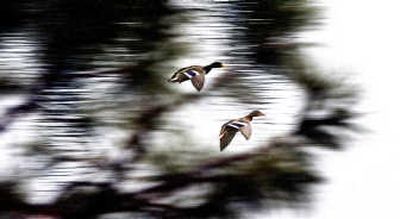Ultimate I.D. challenge

No matter how good you think you are at identifying ducks, it’s easy to get confused, especially in the dim light of dawn or dusk.
“Even the most experienced waterfowl hunter, on any given day, might have to use multiple skills to identify specific ducks,” said Mark Kakatsch, a Wisconsin waterfowl guide who gives seminars on how to identify ducks.
The three main areas of focus that Kakatsch uses for identifying ducks are the sound, the shape or silhouette, and the flight characteristics.
“On a sunny day, you can add color,” he said.
Duck species can be divided into two categories:
“ Puddle ducks, which are found in shallow marshes, include mallards, teal, pintails, wood ducks and shovelers.
“Diving ducks, which favor deeper, open water, include canvasbacks, bluebills, red heads and ringnecks, sometimes called ring-bills.
“Most puddle ducks are more vocal than divers,” said Kakatsch.
Mallards are one of the most commonly hunted ducks in North America. But federal regulations restrict hunters to shooting no more than one hen mallard a day, requiring hunters to identify the species as well as the sex before shooting ducks that often are coming fast in low light.
The mallard species is relatively easy to identify. It’s a big duck with a long neck and a steady, deliberate, graceful wing-beat. Flocks often fly in “V” formation, circling a decoy spread before landing or moving on. But distinguishing a drake from a hen can be difficult, particularly early in the season.
After mating in the spring, drakes lose their bright “green-head” plumage and, for a while, they resemble hens. This is called eclipse drake plumage. During this time, Kakatsch relies on the telltale sounds.
“A hen mallard makes a distinctive quack,” he said. “A drake makes a more low-pitched, drawn-out hum or purr.”
If the ducks come in quietly, look at their bills.
“A drake’s bill is olive, and a hen’s is orange,” he said.
However, by November, all male mallards will have distinctive “greenheads” that make identification relatively easy.
Wood ducks make a unique, high-pitched, whiny, “kee-wee” sound.
“They have a shorter neck and a squared-off tail, unlike the mallard’s rounded tail,” Kakatsch said. “When it’s light enough, you can see their crown, a tuft of feathers extending from the back of the head.”
Wood ducks also have a more erratic flight pattern.
“They don’t work the decoys by circling around,” he said. “They either drop in on the first approach or they give you a look and keep on going.”
However, by November, most wood ducks have left the Inland Northwest for warmer climates.
Teal are the smallest puddle ducks.
“They’re basically shaped like a mallard, but they’re only about a third the size,” Kakatsch said. “A green-winged teal makes a short whistling peep. A blue-winged teal makes a hoarse series of tick-tick-ticks.”
Teal have quick wing-beats and fast, erratic flight.
“Teal like to fly in tight clusters, sometimes, just over the cattails,” he said. “They do a lot of aerial acrobatics, changing altitudes and directions.”
Canvasbacks are the biggest of the diving ducks.
“They have a distinctive, angled, wedge-shaped bill,” Kakatsch said. “They tend to fly in straight lines or `Vs,’ but they’re faster than mallards and you can usually see some white on the body.”
Many duck identification books, pamphlets and videos are available, and Kakatsch encourages hunters to study them.
“Lack of identification skills could end up costing you money in fines for over-bagging of a specific species or by shooting a protected, non-huntable species,” he said.
The books help, but Kakatsch said: “The best way to learn is to spend time in the marsh.”